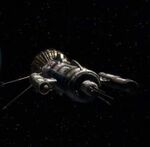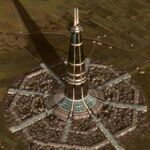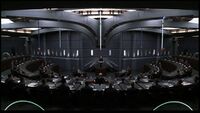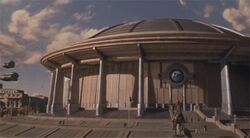User:MJ/sandbox/United Earth Commonwealth
This article is written for the United Earth Commonwealth set in the 22nd Century
The United Earth Commonwealth (UEC) is the government of Earth (and its subsequent colonies and territories) after the unification of the nation-states of Earth in the twenty-second century. It is a federal parliamentary republic with a President as the head of state and a Prime Minister as the head of government. The government, like most republic democracies, has three branches: the executive, the legislature and the judicial. Each one is separate from the other but cannot exist and operate without the other. It is sometimes referred to as the United Earth Government (UEG). By the mid-twenty-second century, the UEC was an emerging power and became a founding member of the Coalition of Planets.
Historical Conception
The government came to existence after the end of hostilities from Earth’s horrifying Third World War and Doctor Zefram Cochrane’s historical warp-flight in 2063. It had united humanity in a way no one ever thought possible. Humans realised they were not alone in the universe. Poverty, disease and war were all gone within fifty years. First contact with the Confederacy of Vulcan changed Earth; the ideology that humanity could no longer fight among themselves as there was a whole galaxy out there that needed to be explored inspired a generation. It was a reminiscence of the mid-20th century shortly after the Second World War ended, people were fascinated about space exploration again. Like the old space race to get a man on the Moon, science-led humanity’s efforts to improve itself. Technological breakthroughs were often and were making a difference to restore what had been lost from World War Three. Sadly though, the people of Earth were now living in the post-atomic horrors and they needed to rise above the current status quo, or they would remain primitive still in the eyes of their new extra-terrestrial friends. They needed to become more enlightened and responsible with their actions. Even though over six hundred million were dead from the former global conflict and many nation-states lay in ruins, what governments did remain worked hard to rebuild and to change the direction of humanity for future generations. Social injustices were dealt with in a more humane way, while scientific innovations continued to build on a global revolution. The New United Nations, a political entity that had transformed from being the Western alliance that had fought against the Eastern Coalition to being one that now promoted global peace, had collapsed by 2078. However, its groundwork highlighted and encouraged the success of the United Earth Movement. This political drive was championed by a number of people from all walks of life across many nations. Rallies, demonstrations and conventions took place in countless cities across the world. The movement electrified many to step up to the challenge to bring Earth out of the ashes it currently laid in and promote on a worldwide stage the single value of hope. The movement wanted to empower people to feel that they could make a difference and they were stronger working peacefully together. By the start of the twenty-second century, a majority of Earth’s national governments had been re-established, yet old rivalries no longer existed. World leaders and the next generation of politicians finally realised that they could no longer allow ancient enmity and hatred to remain in this new world order. The European Hegemony, the Pan-African Alliance and remnants of the Eastern Coalition (the three largest super-states at the time) with other nation-states began the groundwork to establish the United Earth government. The first attempt to establish an Earth republic failed in 2113 due to a number of governments pulling out of the original deal.
Mass demonstrations took place over the next decade by the people of Earth, demanding that their elected officials returned to the negation table and make the world government happen. It was an idea that was popular among many civilians, no one wanted another global-level conflict. It was a time to end the fighting, as many knew it would end humanity. Eventually, a majority of countries finally agreed to a new accord. Certain countries had their reservations with joining outright, however on September 1st, 2130 the Traité d’Unification was signed in Paris at the Place de la Concorde. The treaty became the government’s charter (it was also referred to as the United Earth Accords as well as the United Earth Constitution). Those countries that had not joined (at the time only three: China, the United States of America and Australia) became allies of the United Earth government through separate treaties for each country. Twenty years later, they would all eventually sign the treaty and become members of the UEG.
As two of the main instigators of the treaty from the European Hegemony, France and the United Kingdom of Great Britain invited the UEG to establish the government in their capital cities. Both countries had recovered quickly from the end of the war and were in a good position to host the new world government. The executive branch (which included the offices of the President and Prime Ministers along with cabinet members and their respective departments) was located in London while the United Earth Parliament would be situated in Paris. The President’s residency was located on the Greenwich Peninsula along the River Thames in a brand-new building called the Palace of Hope. It was given Royal approval by the British Monarch and provided to the UEG as a gift from the Royal family. The Prime Minister’s main office was located nearby in the rebuilt Queen’s House and the Old Royal Naval College, again in Greenwich. It was felt the use of Greenwich as the location, which gave its namesake to the Greenwich Meridian Line, would be a symbolic gesture. This was where the compass points of west and east met centrally and this had been agreed upon centuries before. The need to promote the unity of the western and eastern sides of the world was crucial after the Third World War. No longer were they enemies, both sides had come together to govern the world, so it seemed apt that the new leaders of Earth would have their offices located in such a symbolic and historical location. While in Paris, the French government had the United Tower (Tour des Unis) constructed on the site where the Treaty of Unification was signed in the Place de la Concorde. The Tower would house the United Earth Parliament. The location of the third branch, the judicial, was finally settled and once again some historic nostalgia came about when Geneva, the capital city of Switzerland, was asked to host the United Earth Supreme Courts. It was felt that Geneva, being the location of the historical summit from the 19th century that helped define international law standards for humanitarian issues, would be a fitting place for the new global courts. Though some disagreed with the idea of the European Hegemony, housing all three branches of the government, those who protested against it were from countries that had suffered heavily from the former global conflict. They did not have the infrastructure, resources and land that had not been radiated from nuclear warheads to undertake such a feat. The United Earth Movement ended up placing serious pressure on these nation-states to agree to the use of London, Paris and Geneva. Everyone just wanted the government formed and to end the ridiculous political conflicts from previous centuries. Government buildings were set up in each nation’s capital cities to ensure a smooth line of communication took place between the UEG and national governments too. Eventually, the UEG evolved into the Commonwealth as colonies and further territories were established beyond Earth. This allowed Earth to finally look past the Sol system and begin making relations with other species, besides the Vulcans.
Timeline of significant events
- 2053: World War III ends. Over six-hundred million are killed with a majority of world governments in ruins. Those governments that remain take part in signing a cease-fire treaty in San Francisco, USA. For the next decade, most countries look inwards to rebuilding and helping their own civilisations. Only a few, begin providing humanitarian efforts to others. The world economy remains in a state of great depression with stock markets remaining at the same levels they were at the start of the war. Trade between countries is limited.
- 2063: Zefram Cochrane launches the Phoenix, Earth’s first faster-than-light ship. His test flight catches the attention of a nearby Vulcan survey ship, the T’Plana-Hath, which investigates the warp signature. The Vulcans land their ship in Bozeman, Montana and make official first contact with Humanity.
- 2065: The United Earth Space Probe Agency (UESPA) is established, the first planet-wide space program. The motto of the organisation was set as “Science leads”. Deep space probes and colonisation programs are developed on the back of Doctor Cochrane’s work. The Vulcan government agrees to assign advisors and consultants to help the agency.
- 2067: The UESPA launches the first of ten deep space probes using warp drives. The first probe, Friendship 1, is launched from Cape Canaveral, Florida. Over the following year, the remaining nine probes are launched – all heading in different directions. Also, this year the UESPA starts to establish bases on Luna, Mars and other asteroids.
- 2068: The UESPA begins to search for other Earth/Minshara-type worlds. Project Terra Nova is set up after it is decided that Alpha Centauri III, the nearest habitable world to Earth, may be too harsh for Humans to settle on. As a result of constant exploring with the Friendship probes, humans discover a habitable world in the Eta Cassiopeia system. After a number of details scans are taken by Friendship 1, plans are put into place to set up a colony. The planet would be named Terra Nova.
- 2069: The SS Conestoga is sent to Eta Cassiopeia III with over two hundred colonists.
- 2078: The New United Nations collapses, but the United Earth Movement (which had been born on the ideologies promoted by the UN) continues to gain popularity across the world. The collapse though does trigger what is called the Post-Atomic Horror in many countries, especially those that were member states of the Eastern Coalition. The Vulcan government provides support for the humanitarian crisis that has existed for over twenty years now. They provide food, clean water, clothes, shelter and basic medical support. Also, the Conestoga finally arrives in the Eta Cassiopeia system and the Terra Nova colony is founded.
- 2081: The Post-Atomic Horror era comes to an end by the fact nations work together to end the social injustices, poverty and diseases that ravaged so many. The UESPA has the biggest impact on developing a culture of multi-nations working together. It is scientists, engineers, mathematicians and philanthropists that lay the groundwork in pushing forward the need for all of humanity to work together. This pressurises politicians and leaders of many nations to reconsider current policies and strategies.
- 2083: The London Conference, hosted by the British government, takes place and a majority of world leaders and delegates meet to discuss moving forward in establishing world-wide peace for all of humanity. The goal of a United Earth Republic is proposed, and agreed and the aim to have it established is set for 2113.
- 2091: The UESPA leads a multi-nation project and establishes further colonies on the Moon. The Lunar Colonies are established and within four years more than two hundred thousand people settle there. A majority of them join the various businesses that are setting up mines.2103: Once again, the UESPA leads another joint international effort to fully terraform Mars. They are successful in establishing self-sustaining civic environments, based on the designs of the Millennium Gate. This resulted in the first Human colonies on Mars being established successfully. Large quantities of people are desperate to leave Earth and apply to become settlers. Within a year over a million people migrate to Mars.
- 2105: The Martian War of Independence takes place and has a significant impact on Earth’s economy and political will. The Fundamental Declarations of the Martian Colonies grants Mars local autonomy from the governments on Earth. This leads to a change in Human rights, primarily for those who decide to live away from their nation-states beyond Earth.
- 2113: Unfortunately, the United Earth Republic fails to form due to a number of nations pulling out of the agreement. Nevertheless, some of the treaties that had been worked on are formalised. Open and free trade among nations is re-established and the World Trade Organisation is reformed. Further international agencies and programs are either renewed or created. The UESPA receives further funding and has its mandates expanded to undertake further missions to explore space and establish more colonies. A new branch within the UESPA is formed: Starfleet. Starfleet becomes the formal active division that aims to deal with scientific and space exploratory matters.
- 2115: Frustrated at world leaders, a group of humans (including Zefram Cochrane) leave Earth in a series of colony transports. They head to Alpha Centauri III and begin to develop the world as an independent colony.
- 2125: World leaders gather in London again in response to the civilian uproar over the failed attempt at the United Earth Republic. The London Agreement lays out plans for the establishment of the United Earth Government. All nation-states that sign have five years to prepare for the new world government to take place. The signing of the treaty is well received around the world, except by the people who live in the United States of America, China and Australia. These three countries decide not to join the world government as fully-fledged members, but all three become associated with the UEG. Representatives from human colonies beyond Earth are involved in the process too as plans are drawn up to unite all humans under one government.
- 2130: The Traité d’Unification is signed in Paris, France. The United Earth Accords become the constitution for the new world order. The Global Defence Force (GDF) is established as Earth’s main branch of the military.
- 2132: The United Earth Government is renamed the United Earth Commonwealth after leaders meet on Luna for a summit to review the success of the United Earth Government. The Luna Settlement is signed, not only does it rename the government, but it also allies Earth and other colonies established by Humans under one government. Nation states, colonies and other territories keep a level of local autonomy, but overall jurisdiction is handled by the Commonwealth. The use of the old phrase the ‘Whole is Greater than the Sum of its Parts’ becomes the UEC/UEG’s mantra.
- 2135: The United Earth Commonwealth formalises a new alliance with the Vulcan Confederacy, part of the work includes further support in developing Earth’s deep space exploration agenda and being a member of the Interspecies Medical Exchange program.
- 2150: After holding their national referendums, China, the United States of America and Australia join the UEG and elections for their MPs and Senators take place in line with the 2150 UEC elections.
- 2155: The Coalition of Planets, a mutual-defence alliance, is created between the United Earth Commonwealth, the Confederacy of Vulcan, the Andorian Empire, and the United Planets of Tellar after dealing with the Romulan Star Empire’s attempts to destabilise the region. Further attacks take place in the 61 Ursae Majoris system and against the Andorian colony on Docana. Eventually, one of the Coalition’s trading partners, the People’s Republic of Coridan, is attacked by the Romulans and the Coalition declares war against the faceless race.
Current territories
Although still establishing itself as a unified galactic state, the UEG has colonies a number of planets and other celestial bodies. A majority of the home system (Sol) has been settled on. Where planets are inhospitable for Humans, the UEG has either set up bases or stations on moons that orbit those planets.
A bulk of the systems occupied by Earth colonists are called the Home Territories due to their proximity (almost within twenty light years) to the Sol System.
- Sol System
- Mercury
- Venus
- Earth (Homeworld/Capital World)
- Luna (Lunar Colonies)
- Mars (Confederated Martian Colonies)
- Phobos
- Deimos
- Asteroid Colonies
- Ceres
- Vesta
- Jupiter
- Galilean Moon Colonies
- Saturn
- Titan – (Titan Colony)
- Janus
- Uranus
- The Shakespearian Moon Colonies
- Neptune
- The Neptunium Moon Colonies
- Pluto
- Charon
- Alpha Centauri Trinary System
- Alpha Centauri A
- Alpha Centauri III
- Alpha Centauri IV
- Quindar System
- New Montana (Quindar II)
- Proxima Centauri System
- Alpha Centauri A
- Tau Ceti
- Tau Ceti IV
- Gault System
- Vega System
- Eta Cassiopeia
- Terra Nova (Eta Cassiopeia III)
- Starbase 2
- Terra Nova (Eta Cassiopeia III)
- Kappa Fornacis System
- Sirius
The UEG also has territorial claim over the following systems:
- Babel
- Babel
- Babel Station – Starfleet/UE diplomatic hub
- Babel
- Calder
- Calder II
- Calder Observatory – Human-Vulcan research station
- Calder II
- Tarod
- Tarod IX
- Tarod Outpost – Human Settlement, includes a trading base
- Tarod IX
- Berengarius
- Berengaria VII
- Starbase 1
- Berengaria VII
- 61 Ursae Majoris (Archer system)
- Archer IV (Location of Archer IV colony that had to be abandoned in 2155)
Structure
When the Traité d’Unification was being worked on it was the common agreement that nation-states would still have their own governments – however, their powers would be limited slightly. They would have devolved powers of responsibility; this would mainly be on domestic matters that affected their countries. Subjects such as global domestic matters, foreign issues or military ones would be handled by the UEG. Nation states still could keep their militaries but were expected to work alongside other UEG members in unified-joint matters. The Global Defence Force (GDF), the newly established world military, would have overall command. It was written into the treaty, that no nation could start a military conflict with another too. Alongside the GDF, the UEG would have its own space agency: Starfleet. This was originally a branch within the United Earth Space Probe Agency (UESPA), overall it was felt that Starfleet would eventually lead Earth’s exploration efforts.
Succession from the UEG was an issue that had been heavily debated, but it was felt by all that this could not happen as it would cause rise to unnecessary tension that no one wanted. As a result, once the nations of Earth had signed the treaty then that was it – they were in it for good. As well as this, larger super-states like the European Hegemony and Eastern Coalition would cease to exist as they were no longer needed as the UEG would supersede all former treaties among these global powers.
The UEG is undertaken by three inter-connected arms of government. They are:
- The Legislature: The United Earth Parliament (House of Representatives and the Senate).
- The Executive Branch: Includes the Office of the President of the United Earth Government, the Office of the Prime Minister of the United Earth Government with the Ministers and their Departments.
- The Judiciary: The United Earth Supreme Courts and subsidiary national courts.
The Legislature Branch
The United Earth Parliament
The House of Representatives
The House of Representatives is an elected chamber with one-thousand-two-hundred-eighty-four seats for Members of Parliament (MPs) to be voted in for. Each seat represents one constituency across the commonwealth. On Earth, each nation-state, based on recent population data, is approximately divided up into constituencies or districts that are represented in the House of Representatives. Colonies and territories beyond Earth are represented in the chamber. However, unlike on Earth where each nation is divided up, the colonies are divided up based on the settlements’ size as well as data population.
The House of Representatives is referred to as the lower chamber of Parliament. A majority of the executive government is formed by this chamber too. The Prime Minister, Deputy Prime Minister and Ministers for each executive department are taken from the House, based on nominations from the President with advice from the Prime Minister before they are confirmed by the Senate.
If not all, most of the legislative agenda is set by the House and voted on first by MPs. Once it is agreed by the House of Representatives, it moves to the floor of the Senate before receiving either the Presidential seal of approval or being vetoed.
The House is presided over by the Speaker of the House. They are elected to the position by MPs after a new term for the chamber begins. Normally the Speaker is a representative from the party (or coalition) that commands the majority in the House.
The Senate
The Senate is a selected chamber, it has four-hundred-twenty-eight members. Each nation-state on Earth and every colony gets to pick two people who will represent their government in the United Earth Parliament. Senators are appointed to a single term every six years, just like the President and Vice President. It is expected that the elected government of each nation/state/colony, will vote in their own legislation on who will be appointed to represent them. It is then down to the head of state and head of government to publicly confirm and announce the two people their government has nominated to the Senate.
Due to the nature of the work the Senate undertakes, it acts as a check on the House of Representatives due to being independent of the electoral process. However, Senators are normally members of certain political parties, caucuses or interest groups. As such partisan views take place in the Senate as much as they do in the House of Representatives. As a result of this, the political party/coalition that controls a bulk of the senate is led by the Majority Leader, while those in opposition are led by the Minority Leader. The Senate itself is chaired by the Vice President, who holds the position of Chairperson of the Senate when they attend sessions.
The Senate is considered the upper chamber of Parliament. The Senate scrutinises bills that have been approved by the House of Representatives. It regularly reviews and amends legislation from the lower chamber. Senators can delay new laws from reaching the president for approval and can force the House of Representatives to review their suggestions or amendments. If this takes place the Senate does not vote on the issue and it is returned to the House of Representatives. Once a law is passed by the House of Representatives and the Senate it is sent to the President for presidential approval.
On rare occasions, some Senators (based on their experiences, skillset, knowledge, etc.) are appointed to become part of the executive government in various state departments, with some taking on a ministerial position.
It is also the job of the Senate to confirm any presidential nominations to the executive and judicial branches of the government.
Joint Sessions
It is rare for both chambers to meet together; this normally takes place during the President’s Speech at the opening of a new parliament or during the Prime Minister’s State of the Commonwealth speech. The President can request an extraordinary joint session, this is normally reserved for emergency/important reasons (e.g.: security matters, economic issues, etc.)
Checks and balances
Due to the large number of officials in both chambers, the House of Representatives and Senate work together through various joint sub-committees. These sub-committees are aimed to support the Houses of Parliament in its role as an extra layer of oversight of the executive government departments and their agencies, e.g.: budget spending, military affairs, elections, etc. There are a number of statutory sub-committees that the Traité d’Unification has listed. However, the Senate and House of Representatives can vote upon the creation of temporary subcommittees if there is a requirement. A majority of these joint sub-committees are chaired by Members of Parliaments, in some cases like the Joint Foreign Affairs Sub-Committee, they are jointly chaired by an MP and a Senator.
Eligibility
To be eligible to hold a seat in either the Senate or House of Representatives, one must:
- be at least twenty-five years of age;
- be a born citizen of the United Earth Commonwealth.
One is ineligible to hold the office if:
- they are convicted criminal and after a review and decision made are disqualified by the Electoral Commission.
The Executive Branch
Office of the President of the United Earth Government
See: President of the United Earth Commonwealth
The Earth President is the head of state for the Earth and its Commonwealth. The office holder is voted in by the people by a direct popular election. The presidency, for each successful candidate, is a six-year term. A president can only be elected for two terms (twelve years in total if a candidate can win two consecutive terms). When a president is elected, they are also elected alongside their running-mate who becomes the vice president.
Office of the Vice President of the United Earth Government
The Vice President is a position within the Earth's government that is meant to support the Presidency and is first in line to succeed the president if they resign or die while in office. If either of these happens, the Vice President will assume the office of the President and the responsibilities and powers it comes with.
Although the Office of the Vice President does not have major importance within the Executive Branch compared to the Presidency and Prime Ministership, the Vice President is also an officer within the legalisation branch as the post-holder presides over the Senate. The Vice President will chair sessions of the Senate and can only vote when there is a need for a tiebreaker. If the Vice President is unable to preside over the senate for a session, they are able to nominate one senator of their choice (normally someone from their own political party or who holds similar political ideology) who would act in their place. However, they are unable to carry the Vice President’s ability to vote for a tiebreaker.
The Vice Presidency is also expected to take on a number of ceremonial duties on behalf of the President, this can include attending a range of functions both domestic and foreign.
Office of the Prime Minister of the United Earth Government
See: Prime Minister of the United Earth Commonwealth
Often referred to as the de-facto leader of the Earth Commonwealth, the Prime Minister effectively runs the day-to-day government. They are an elected Member of Parliament who sits in the lower chamber of Parliament in the House of Representatives. They are sometimes referred to as the Leader of the House as they are expected to command a majority.
Cabinet Members of the Executive Government
See: Cabinet of the United Earth Commonwealth
When the Cabinet meets, the different heads of departments gather to discuss government matters.
The following leaders of the executive government are expected to attend:
- President of the United Earth Commonwealth
- Vice President of the United Earth Commonwealth
- Prime Minister of the United Earth Commonwealth
- Deputy Prime Minister of the United Earth Commonwealth
Executive Department Heads:
- Secretary of State for Foreign & Commonwealth Affairs
- Secretary of State for the Home (Interior) Department
- Secretary of State for Defence
- Secretary of State for Treasury
- Attorney General
- Secretary of State for Health
- Secretary of State for Education
- Secretary of State for Business & Trade
- Secretary of State for Environment & Energy
- Secretary of State for Labour
- Secretary of State for Housing
- Secretary of State for Transport
Cabinet level members:
- Chiefs of Staff for the President, Vice President, Prime Minister & Deputy Prime Minister
- Commonwealth Security Advisor
The Judicial Branch
The Supreme Court of the United Earth Commonwealth
The Supreme Court is made up of fifteen judges, one who is nominated as the Chief Justice and the others known as associate justices. The Supreme Court is the highest court in the Commonwealth. The purpose of the Supreme Court is to ensure that all courts in the Commonwealth follow the law of the land, as set out by the Traité d’Unification/United Earth Accords. It acts as a mediator when there are issues between nations and/or colonies of the Commonwealth.
Appeals from lower courts can reach the Supreme Court, but these types of cases are rare. When it is suspected that parts of the United Earth Accords have been broken, then this is when the Supreme Court intervene. This can also include any legislature from Parliament or executive orders from the President. If the Supreme Court think that the government has acted in an unlawful way, it can overrule any legislation or executive order.
Judges are nominated by the President and confirmed by the Senate. Judges remain in their positions for the rest of their life, unless they resign or retire. Judges can be removed from office through an impeachment process that requires a two-thirds majority of support from Parliament.
Current political parties
See: United Earth Political Parties (22nd Century)
Like any democracy from Earth's history, political parties are well-known established institutes that work as part of the government's ability to function. However, a majority of these parties are quite liberal and progressive in their ethos in the 22nd Century.
The United Earth Commonwealth In Play
- This only refers to the UEC/Humanity during the 22nd Century:
- Earth with its Commonwealth of Nations and Colonies is relatively young in comparison to other galactic states. A whole generation (or more) only knows of peaceful living and not many races are known to the Commonwealth by 2155.
- At the centre of the Commonwealth's approach is the peaceful exploration and mutual cooperation with other races. It is the founding, if not leading nation of the Coalition of Planets.
- This era of Earth's sociological and political development is on the tipping point between 21st century Earth and 23rd/24th century Earth. Some people on Earth still follow a religion and Humans aren't as 'enlightened' as later generations will be. The acquisition of wealth is no longer the main driving force in most people's lives, but there is still a need across Humanity to accumulate items. The New World Economy is still in its infancy. A majority of humans do believe in the idea of working to better themselves and the rest of humanity - however, not everyone follows this ideology.
- The colonies of Earth do hold some resentment towards the homeworld at the fact that those who have decided to immigrate found themselves having to work harder at their new lives on newer worlds/colonies.
- Nation states of Earth still hold some semi-autonomy power over the countries from the UEG. This is the same for colonies, however, where most colonies have a governor as a de-factor leader there are some (like Mars) that have a different government system.






